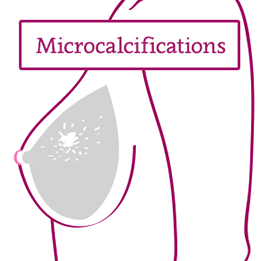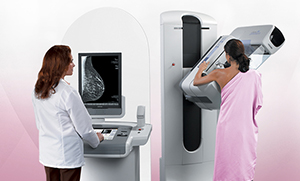Microcalcifications
Microcalcifications are small calcium deposits in the breast that can only be detected on a mammogram.
 The cause of microcalcifications is unknown, and 80% of microcalcifications are not indicators of cancer or a precancerous condition.
The cause of microcalcifications is unknown, and 80% of microcalcifications are not indicators of cancer or a precancerous condition.
Appearance
Microcalcifications can appear as fine white lines or small white specks scattered throughout the breast or grouped in clusters. When closely evaluated, microcalcifications have very specific characteristics. Experienced radiologists can often categorize these characteristics as being associated with benign or malignant processes.
Magnification Views
Some types of microcalcifications require further evaluation with additional views. These views are called magnification views. When the microcalcifications are magnified, the radiologist can evaluate the contour, shape, number, and grouping of the microcalcifications. As the calcifications are evaluated on magnified views, the radiologist will classify them as benign or suspicious, which will determine if a biopsy or mammographic follow up is indicated.
Follow Up Is Important
Mammography has become a useful tool in early detection of breast cancer because radiologists have been able to evaluate small changes in the breast, such as microcalcifications. Follow-up mammography for patients with microcalcifications is very important.
Finding a change in the pattern or finding new microcalcifications may allow for early detection of small or early breast cancers. As always, the mammography results are only part of your breast health program. Your program should also include regular physical exams and your monthly breast self examinations. All of this information is important in providing the best breast health care.

Genius™ 3D Mammography
Genius 3D mammography detects 41% more invasive cancers and reduces false positive exams by 50%.

